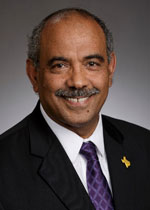January 11 – As the COVID-19 pandemic intensified across the globe in early 2020, Prairie View A&M University (PVAMU) Endowed Professor Ali Fares, Ph.D., knew it was time to shift gears regarding his research efforts.
He reached out to College of Agriculture and Human Sciences Research Scientist Ripendra Awal, Ph.D., to propose a research study exploring the effects of the world’s response to the COVID-19 pandemic on air quality.
“If we were to do a study showing the impact of human activity on air quality, it would be impossible because you can’t just ask everyone to stop emitting or at least emit less. It wouldn’t be practical,” Fares said. “The stay-at-home orders and quarantine were a once in a lifetime opportunity we needed to take advantage of.”
That thought led the team to compare rates of pollutants before and after the COVID-19 pandemic. Fares and Awal, along with the Postdoctoral Researcher Hamideh Habibi, utilized air quality data from the World Air Quality Index project to identify the levels of pollutants — particulate matter, carbon monoxide, nitrogen dioxide, ozone, and sulfur dioxide — in the air in some of the world’s most polluted cities.
The team downloaded, processed, and analyzed data from January 2019 through April 2020 to identify any changes to the level of the pollutants from February to April 2020 from the same time frame in 2019.
Their research results showed that countrywide shelter-in-place, stay-at-home, closure, and shutdown orders, and border control measures issued around the world in response to the COVID-19 pandemic decreased levels of the majority of the pollutants in the air throughout the world.
In Wuhan, China, nitrogen dioxide levels decreased by 63 percent. Carbon monoxide levels in Lima, Peru were reduced by 61 percent, the same decrease in particulate matter recorded in Berlin, Germany. Of the two United States cities included in the study — Seattle and Washington, D.C. — a 23 percent decrease was identified.
Ozone levels increased significantly in Milan, Italy where levels rose by 86 percent. Fares said this increase is the result of titration — a reduction in the gases that consume ozone, which leads to an increase in the pollutant. Seattle and Washington, D.C. experienced a 10 percent and 25 percent decrease in ozone, respectively. The study attributed the increase to meteorological conditions such as temperature and wind speed.
With the research study completed, Fares is looking to localize the results and determine the impact locally in the Houston area. He intends to partner with the Houston Advanced Research Center to study the air quality in some of Houston’s most vulnerable, underserved areas.
“If you go into some areas of Houston, you see that you have industrial areas and pollutants that don’t exist in other areas,” Fares said. “The type of research that we can do can highlight those issues and bring attention to them, so those findings can be used to advocate for reducing, eliminating, or addressing those issues.”
For more information on this article contact:
 Ali Fares, Ph.D.
Ali Fares, Ph.D.
Endowed Professor
alfares@pvamu.edu
(936) 261-5095

